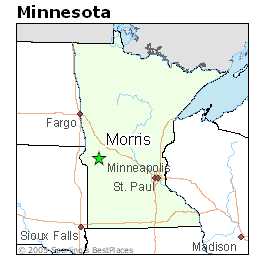A U.S. Civil War testimonial this far to the west might be deemed rare. Morris was not founded until 1871, six years after the great conflict ended. We're also too far to the north to have been touched by the very nasty conflicts that involved non-uniformed combatants. The movie "The Outlaw Josey Wales" would give you a primer on that.
But we have a significant tangible gesture to the Civil War in this community. Yes, it's a gesture to the winning side. The "running rifleman" statue in Summit Cemetery ought to be admired by everyone who has ever lived here. I wonder whether a lot of the newer residents know about it. Also called the Sam Smith statue, it's a replica of a statue that graces the Gettysburg Battlefield (national park).
You will also find a mansion style of home in west Morris that has a whiff of the Civil War. The home was built by the son of President Abe Lincoln's secretary of war (last name of Stanton). Some past occupants of that house were known to refer to it as "the house of chimneys."
Civil War veterans made their way out here around the turn of the century, including one, Amos Pushor, whose background I studied when I was in the local media. He lived to an advanced age and was remembered by some local residents at the time I did the research.
"He was an old-timer (even) back then," I remember someone saying, the point being that the Civil War was very remote in time.
These veterans marched in parades until they couldn't march anymore and then they rode on wagons. Most seemed to sport long beards. You had to imagine when they were in their prime and could perform the kind of bold charge as represented in the "running rifleman" statue.
The statue is a tribute to the First Regiment of the Minnesota Volunteer Infantry. It was a subject of special research by John Q. "Jack" Imholte in the days when he was polishing his academic credentials. The retired University of Minnesota-Morris chancellor - it was called provost then - wrote a book about the celebrated Minnesota unit. It's at the Morris Public Library.
We are privileged to have an exquisite replica of that Gettysburg statue which would have to rank as one of the most artistically striking monuments there. Gettysburg, Pennsylvania, became the focal point post-war for the various military units, both North and South, to be remembered with monuments.
The First Minnesota was in several of the best-known engagements of the Civil War, paying a dear price. But the conflict of July 2, 1863, stands out. It was the day when the Union's Army of the Potomac "came of age," according to Civil War artist Dale Gallon. Gallon talked about "a stoic determination to hold the ground." The artist did a limited edition print on the First Minnesota but I found it to be too bleak in content to purchase. The dead and wounded are visible.
The artist thought it important to capture the intensity of small unit combat at this pivotal clash which occurred at dusk in a swale.
Gallon was most familiar with the memorial statue. He noted that every time he passed by it, he "tried to imagine what those men saw and thought when (Major General Winfield) Hancock ordered them forward."
He continued: "I had read of the charge many times and marveled at their discipline and valor. I also became engrossed in accounts of their gallant stand down in the swale. For ten minutes, suffering crippling losses, they held the Confederates at bay while Hancock brought up critical reserves. I knew that what I wanted to capture (in the painting) was hidden somewhere down in that smoky hollow."
You might want to check out Imholte's book and then make a visit to our Summit Cemetery, close your eyes and imagine the same valor as Mr. Gallon did. His painting shows a row of soldiers (the ones having survived Confederate bullets to reach that position) delivering their volley. It was Day 2 of the celebrated battle. The day was coming to a horrific end along the upper reaches of Plum Run west of Cemetery Ridge. A hole in the Union line had to be plugged.
I remember running into Imholte at the City Center Mall restaurant after I had read the book "The Killer Angels." (The mall restaurant hadn't yet taken on its Chinese theme.) Aware as I was of Imholte's research, I had to ask him about some of the perceptions offered by that book's author, a Pulitzer Prize winner. The book was a wondrous historical novel about the Gettysburg battle. It was a key inspiration for the Ken Burns Civil War documentary.
The author made Confederate General James Longstreet a sympathetic figure. The sympathy was not for the basic Confederate cause. Author Michael Shaara, RIP, felt that Longstreet's dissenting opinions during the Gettysburg campaign were valid. The general was a right-hand man to the iconic Robert E. Lee and it was Lee, obviously, with the final say.
Lee went with his pugnacious instincts. He wasn't inclined to finesse or patience. But he was in unfamiliar country and outside the South, so perhaps a little more finesse and deliberation were called for. I asked Imholte if Shaara's sympathetic portrayal of Longstreet, from the standpoint of military acumen, was justified. He answered yes.
Longstreet desperately wanted Confederate forces to assume a defensive stance in this campaign - to find good ground and induce a Federal attack. The Federals were under great pressure to push back the rebellion. Surely they would act swiftly and perhaps with impulsive recklessness to try to throw the rebels out of Pennsylvania.
Longstreet's pleading was unsuccessful. He grew sullen. After the war he became a scapegoat in the eyes of the "Lost Cause" adherents in the South.
It was Longstreet's assault that had to be checked on July 2, 1863, when the Minnesotans ran directly into that withering fire amidst twilight.
The running rifleman statue captures perfectly the sense of duty and willingness to sacrifice. This unit prevented the Confederates from pushing the Federals off Cemetery Ridge. This charge versus a much larger enemy force was a ploy to buy time. The unit's casualty rate was a staggering 83 percent. Those still standing helped repulse "Pickett's Charge" the next day.
I asked Provost Imholte if he had seen the movie "Gettysburg" which was current at that time. He hadn't yet seen it. But he was aware that the First Minnesota wasn't represented in it, and he seemed disappointed.
The first part of that movie focused on the bayonet charge on Little Round Top. Jeff Daniels played Joshua Chamberlain who led that charge. After intermission we got to appreciate Pickett's Charge which basically came across as a big slaughter.
Pickett's Charge could more accurately be called Longstreet's Charge. Longstreet was a tragic figure in the movie. He seemed to have the sense and savvy to know the best strategy. Lee, seeming almost confused and disoriented at times, wanted a fierce, all-out assault even if all the parameters weren't known.
Lee's top cavalry commander was gone for much of this battle - a significant handicap (or so it's suggested). Actually you could put together a list of screw-ups, but the bottom line was that fate and destiny were working against this rebellion. Its resources were inadequate, its numbers were being reduced and it lacked the kind of political footing it needed even in the South.
Pundit George Will has written that the Union forces won because they simply killed all the Confederates. Will wrote this shortly after the terrorist attack of 9/11, suggesting that we'd have to make a comparable effort to simply kill all the terrorists. Analogies are dangerous, of course.
We can't begin to relate to a United States that could be torn apart by the Civil War. We can't relate to the kind of brutal hatred shown in the "Josey Wales" movie or the travels of Jesse James. James of course wasn't some sort of Robin Hood outlaw, deserving of a mixed appraisal. Folklore might have nudged him in that direction, but in fact he was a figure that grew right out of the Civil War.
James was a Confederate guerrilla. His side lost and with virtually no nuances suggesting otherwise. That's why they ended up killing each other. That's why gravesites of some of the most famous Confederates aren't even well tended (which I learned in a book by Tony Horwitz, who had a hard time even finding a significant cemetery).
Lee had only the most tense contacts with his former comrades after the Civil War. Whenever a lawyer wants to make an analogy that suggests total defeat, he/she cites the Confederacy of the Civil War. A whole class of people - the planter aristocrats - was wiped out.
I suspect that Civil war remembrance is suppressed some today because we want to feel brethren with southerners.
But the sacrifice of the First Minnesota Volunteers, so well documented by Imholte and others, can never be forgotten.
Perhaps a new "Gettysburg" movie will be made someday - remakes are the norm in Hollywood, right? - and it will show that swale lit up by bursts of gunfire in the twilight, as these gallant, running riflemen of Minnesota helped preserve the Union and eradicate slavery.
Make a visit to Summit Cemetery sometime and feel the same awe as artist Dale Gallon.
-Brian Williams - morris mn Minnesota - bwilly73@yahoo.com
Friday, April 30, 2010
Subscribe to:
Post Comments (Atom)






















No comments:
Post a Comment